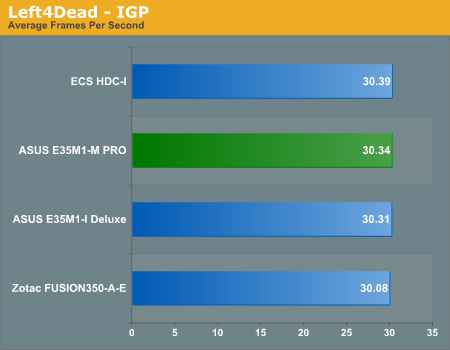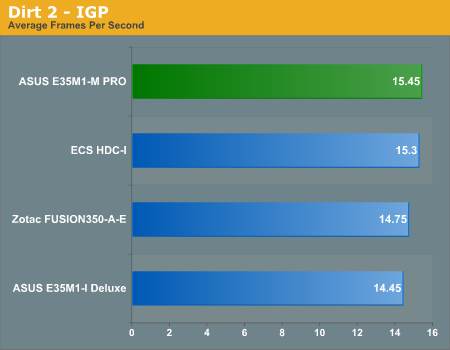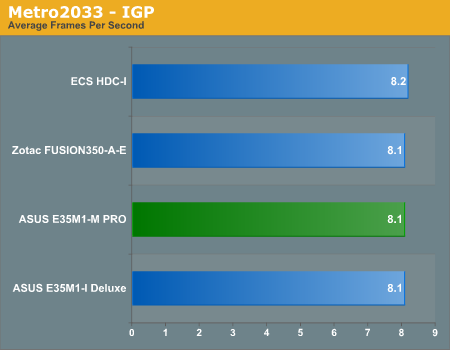ASUS E35M1-M Pro Review - Anyone For Fusion?
by Brendan van Varik on October 25, 2011 5:00 AM EST- Posted in
- Asus
- Motherboards
- Fusion
- E-350
Left4Dead2
Left4Dead2 is a classic Steam FPS DirectX 9 shooter. It changes very quickly from GPU to CPU bound over a certain limit - our test is a time demo taken from a run through of the first level.

30.34 FPS puts the board in second place as well as being just a little bit behind on the top spot.
Dirt 2
Dirt 2 came to the PC in December 2009, developed by Codemasters with the EGO Engine. Resulting in favorable reviews, we use Dirt 2’s inbuilt benchmark under DirectX 11 to test the hardware. We test two different resolutions at two different quality settings using a discrete GPU, and an appropriate integrated GPU setting.

A result of 15.45 FPS puts this motherboard above any other Fusion based system.
Metro 2033
Metro 2033 is a challenging DX11 benchmark that challenges every system that tries to run it at any high-end settings. Developed by 4A Games and released in March 2010, we use the inbuilt DirectX 11 Frontline benchmark to test the hardware.

All of the results collected thus far on the Fusion platform are very similar. There is a 0.1 frames per second difference between the top result and the bottom result so this board fits into right into the middle of the bunch.










66 Comments
View All Comments
mino - Wednesday, October 26, 2011 - link
IF not in a hurry, you better wait for a dual-core E2-series Llano.UrQuan3 - Wednesday, November 9, 2011 - link
I wish I had tested Netflix. 1080p youtube and 720p crunchyroll play fine, but flash has hardware acceleration on the E-350.Since I've gotten several 'free' Nexflix offers, maybe I should test it.
jacob733 - Tuesday, October 25, 2011 - link
What about the other SATA channels? It's nice to see throughput with a single SSD on a single channel, but all sorts of other effects come into play if you load all channels at once. For example my H55 board can be saturated even by LP class magnetic HDDs if I load all 6 channels due to channel sharing of some kind. Would be nice to know as apart from HTPC then E35M1-M Pro also looks perfect for homebrew NAS.firsthour - Tuesday, October 25, 2011 - link
Anyone have any experience running a FreeNAS box off this? I like the idea of the low power along with 5+1 SATA. Max 8GB memory is my only concern that I can think of, considering how hungry ZFS is.Anything else I should be concerned about? Is it worth waiting for an E-450 release?
mino - Wednesday, October 26, 2011 - link
AM3+ along with X2 240e is a far better choice for FreeNAS or simmilar- ECC
- excellent FullATX mobos with a bunch of slots for RAID/NIC's
fubird - Tuesday, October 25, 2011 - link
can I use i3-2100T and thermalright HR-02 to build a fanless system? Since I need 2 HDMI port and and the trend is lossless music file is becoming larger and larger, I don't think APU can handle that for a long run. That's why I prefer SB, but 0dB noise is a must.frozentundra123456 - Tuesday, October 25, 2011 - link
Why not test some older or less demanding games instead of Metro 2033 and Dirt?Both these games are clearly unplayable on this platform, so does a frame per second or two really make any difference?
Maybe try Sims 3, or Half Life 2, or KOTOR or Mass Effect, WoW or something. I cant think of any more specific games that might be actually playable, but I am sure there are a lot of games from the 2005 or so era that might still be fun and actually playable on this system.
Fradelius - Tuesday, October 25, 2011 - link
totally agree, testing crysis on this is not a wise ideawow on the other side.. works!
silverblue - Wednesday, October 26, 2011 - link
http://www.anandtech.com/show/4218/amds-brazo-e350...E-450 would mean a small improvement though not necessarily anything really measurable.
TSnor - Tuesday, October 25, 2011 - link
Article says "The operating system is installed on the OCZ Vertex 3 240GB SSD, which is rated at up to 550 MB/s read and up to 520 MB/s write, and the sequential test is run at the 5 x 1000 MB level on a separate clean partition. "BUT this doesn't work on a sandforce based SSD. The SSD does not respect partition boundaries, it pools all the flash memory to maximize performance and minimize wear. Write speed especially is a function of the size of the data PREVIOUSLY written to the part of the SSD that will be reused. Depending on whether or not the drive was previously written with large block writes (128K, 256K) or small (8K or less) block writes a sandforce controller can see a 2X write speed difference.
Net, I would not give much value to the comparative results of the SSD testing. The differences are probably not SATA port related.